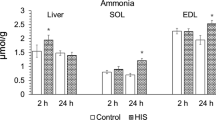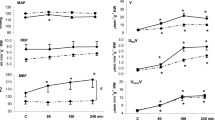Summary
The effects of intravenous administration of propionyl-L-carnitine (PLC) were investigated in anesthetized dogs instrumented for the analysis of general hemodynamic and electrocardiographic data, peripheral blood flows, coronary blood flow and oxygen consumption, urine flow, and renal function. PLC was administered in bolus (20, 60, and 200 mg/kg) or by infusion (20 mg/kg/min * 15 min or 30 mg/kg/min * 10 min). In some cases also L-carnitine (LC) and L-carnitine + propionate (LC + P) were administered in doses equimolar to those of PLC. PLC elicited dose-dependent, short-lasting enhancements of cardiac output, both in open-and close-chest conditions. Arterial blood pressure, heart rate, and contractility varied slightly and unpredictably; the substance did not elicit electrocardiographic effects. These responses were not changed by alpha- or beta-adrenergic blockade, nor by the administration of a calcium antagonist, but they were abolished or reversed by the combination of such blocking interventions. Mesenteric and iliac blood flows were increased by both PLC and LC; LC + P increased these, and in addition increased renal blood flow. A strong diuresis obtained with PLC, LC, and LC + P was due to osmotic clearance following the administration of hyperosmotic solutions. PLC elicited coronary vasodilation with reduced oxygen extraction; this effect lasted longer than the general hemodynamic effects and was not seen with LC. All the cardiovascular actions of PLC can be attributed to its pharmacologic properties, rather than to its role as a metabolic intermediate.
Similar content being viewed by others
References
Bremer J. Carnitine—metabolism and functions. Physiol Rev 1983;63:1420–1480.
Siliprandi N, Ciman M, Sartorelli L. Myocardial carnitine transport. Basic Res Cardiol 1987;82:53–62.
Folts JD, Shug AL, Koke JR, Bittar N. Protection of the ischemic dog myocardium with carnitine. Am J Cardiol 1978;41:1209–1214.
Suzuki Y, Kamikawa T, Kobayashi A, et al. Effects of L-carnitine on tissue levels of acyl carnitine, acyl coenzyme A and high energy phosphate in ischemic dog hearts. Jpn Circ J 1981;45:687–694.
Kotaka K, Miyazaki Y, Kouichi O, et al. Protective effects of carnitine and its derivatives against free fatty acid-induced mitochondrial dysfunction. J Appl Biochem 1981;3:328–336.
Sugiyama S, Miyazaki Y, Kotaka K, et al. Mechanism of free fatty acid-induced arrhythmias. J Electrocardiol 1982;15:227–232.
Hotta R, Sugiyama S, Nagai S, et al. Effects of l-carnitine and l-propionylcarnitine on ischemia-induced mitochondrial dysfunction. J Mol Cell Cardiol 1983;15:S1 n.114.
Curello S, Carnioni A, Ceconi C, Ferrari R. Effects of L-carnitine derivatives on lipid peroxidation of cardiac mitochondria. In: Physiology, clinical aspects and treatment of Coronary Insufficiency. An International Symposium, Torino 1987.
Liedtke AJ, Nellis SH, Whitesell LF. Effects of carnitine isomers on fatty acid metabolism in ischemic swine hearts. Circ Res 1981;48:859–866.
Paulson DJ, Schmidt MJ, Romens J, Shug AL. Metabolic and physiological differences between zero-flow and low flow myocardial ischemia: Effects of L-acetylcarnitine. Basic Res Cardiol 1984;79:551–561.
Paulson DJ, Traxlerr J, Schmidt M, et al. Protection of the ischaemic myocardium by L-propionylcarnitine: Effects of the recovery of cardiac output after ischaemia and reperfusion, carnitine transport and fatty acid oxidation. Cardiovasc Res 1986;20:536–541.
Aomine M, Arita M, Imanishi S, et al. Effects of l-propionyl carnitine on electrical and mechanical properties of guinea pig ventricular muscle and canine Purkinje fibers. J Mol Cell Cardiol 1983;15:S5 n.14.
Cevese A, Blonda P. Analisi automatica di dati emodinamici: prime realizzazioni. Boll Soc It Biol Sper 1983;59:257–263.
Cevese A. Automatic elaboration of hemodynamic data. In: Lown B, Malliani A, Prosdocimi M, eds. Neural mechanisms and cardiovascular disease. Padova: Liviana Press, 1985:553–554.
Elzinga G, Westerhof N. How to quantify pump function of the heart. The value of variables derived from measurements on isolated muscle. Circ Res 1979;44:303–308.
Sarnoff SJ, Braunwald E, WelchJr GH, et al. Hemodynamic determinants of oxygen consumption of the heart with special reference to the tension-time index. Am J Physiol 1958;192:148–156.
Kissling G, Rupp H. The influence of myosin isoenzyme pattern on increase in myocardial oxygen consumption induced by catecholamines. Basic Res Cardiol 1986;81:S1 103–115.
Holubarsch C, Hasenfuss G, Blanchard E, et al. Myothermal economy of rat myocardium. Chronic adaptation versus acute inotropism. Basic Res Cardiol 1986;81:S1 95–102.
Sugimoto T, Sagawa T, Guyton AC. Effect of tachycardia on cardiac ouput during normal and increased venous return. Am J Physiol 1966;211:288–292.
Suzuki Y, Kamikawa T, Yamazaki N. Effect of L-carnitine on cardiac hemodynamics. Jpn Heart J 1981;22:219–225.
Fanelli O. Carnitine and acetyl-carnitine, natural substances endowed with interesting pharmacological properties. Life Sci 1978;23:2563–2570.
Bongrani S, DiLisa F, Raddino R, et al. D,L-carnitine and D,L-acetylcarnitine actions on myocardial contractility and coronary resistance in isolated perfused rabbit hearts. Il Farmaco 1980;35:239–248.
Brooks H, Goldberg L, Holland R, et al. Carnitine-induced effects on cardiac peripheral hemodynamics. J Clin Pharmacol 1977;17:561–568.
Whitmer JT. l-carnitine treatment improves cardiac performance and restores high-energy phosphate pools in cardiomyopathic Syrian hamster. Circ Res 1987;61:396–408.
Author information
Authors and Affiliations
Rights and permissions
About this article
Cite this article
Cevese, A., Schena, F. & Cerutti, G. Short-term hemodynamic effects of intravenous propionyl-L-carnitine in anesthetized dogs. Cardiovasc Drug Ther 5, 45–56 (1991). https://doi.org/10.1007/BF00128243
Issue Date:
DOI: https://doi.org/10.1007/BF00128243




